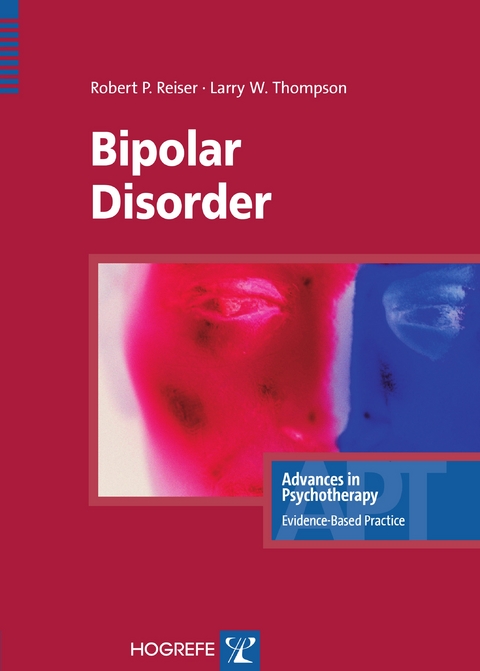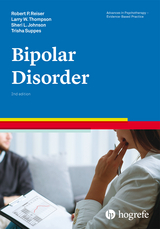
Bipolar Disorder
Hogrefe & Huber (Verlag)
978-0-88937-310-5 (ISBN)
- Titel erscheint in neuer Auflage
- Artikel merken
The past 10 years have seen a dramatic increase of interest in psychosocial treatments of bipolar disorder. There is now substantial empirical evidence suggesting the effectiveness of such treatments. However, this accumulated information has not yet been transferred into clinical practice in many settings. Help is now at hand. This compact volume brings to the practitioner a comprehensive, evidence-based approach to the treatment of bipolar disorder that is practical, easily accessible, and can be readily applied in clinical practice. This practitioner's guide begins by describing the main features of bipolar disorder and considerations for differential diagnosis based on DSM-IV and ICD-10 criteria. Following this, current theories and models are described, along with decision trees for evaluating the best treatment options. The volume then guides the reader through a systematic, integrated approach to treatment, based on the best of recent research. The authors describe a structured directive therapy that is also collaborative and client centered. Special considerations, including managing suicide risk, substance misuse, and medication non adherence, are addressed.
The volume is rounded off by the inclusion of clinically oriented tools and sample forms.
1.1 Terminology 1.2 Definition 1.2.1 Additional Considerations in the Classification and Diagnosis of Bipolar Disorders 1.2.2 Implications for Clinical Practice 1.3 Epidemiology 1.4 Course and Prognosis 1.5 Differential Diagnosis 1.5.1 Differential Diagnosis of Bipolar Disorders I and II Versus Major Depressive Disorders 1.5.2 Differential Diagnosis of Bipolar I Versus Bipolar II Disorder 1.5.3 Differential Diagnosis of Bipolar I Disorder Versus Psychotic Disorders (Schizoaffective Disorder, Schizophrenia, and Delusional Disorder) 1.5.4 Differential Diagnosis of Bipolar Disorder (Current Episode Manic or Mixed) Versus Substance-Induced Mood Disorder 1.5.5 Differential Diagnosis of Bipolar I and II Disorders Versus Borderline Personality Disorder 1.5.6 Differential Diagnosis of Bipolar Disorders I and II Versus Attention Deficit Disorders 1.5.7 Differential Diagnosis of Bipolar I and II Disorders Versus Antisocial Personality Disorder 1.6 Comorbidities 1.7 Diagnostic Procedures and Documentation 1.7.1 Tools to Assist in the Assessment of Bipolar Disorder: Mania 1.7.2 Tools to Assist in the Assessment of Bipolar Disorder: Depression 1.7.3 Taking a good history 2 Theories and Models of Bipolar Disorder 2.1 Biologically Based Disease Models 2.2 General Psychoeducation and Illness Management Strategies 2.3 The Interpersonal and Social Rhythm Hypothesis: Social Rhythm Disruption as a Potential Catalyst for Bipolar Episodes 2.4 Family-Based Treatment Approaches 2.5 Cognitive-Behavioral Treatment Approaches 2.5.1 Basco and Rush Cognitive-Behavioral treatment of Bipolar Disorder 2.5.2 Lam, Jones, Hayward, and Bright (1999): Identifying Prodromes of Illness 2.5.3 Other Cognitive Behavioral Treatment Strategies with Bipolar Disorder 3 Diagnosis and Treatment Indications 3.1 Decision Tree for Determining Optimal Treatments 3.2 Treatment Options 3.2.1 Treatment Options for Young Adult 3.2.2 Treatment Options for High Risk Presentation 3.2.3 Treatment Options for Repeated Episodes of Mania/Hypomania (see the case of Bill in Section 4.1.5) 3.2.4 Treatment Options for Persistent Subsyndromal Depression and Dysthmia (see the case of Tanya in Section 4.4.2) 4 Treatment 4.1 Methods of Treatment 4.1.1 Biological Approaches to Treatment of Bipolar Disorder 4.1.2 Psychosocial Approaches to Treatment of Bipolar Disorder: General Remarks 4.1.3 Overall Structure of the Course of Therapy 4.1.4 Initial Phase of Treatment: Orientation and Engagement 4.1.5 Middle Phase of Treatment: Skill Building - Filling up the Tool Box 4.1.6 Final Phase: How to Maintain Treatment Gains 4.2 Mechanisms of Action 4.2.1 Targeted Psychoeducation and Illness Management Strategies 4.2.2 Monitoring of Activities and Moods 4.2.3 Social Rhythm Disruption as a Catalyst for Bipolar Episodes 4.2.4 Family-Focused Treatment 4.2.5 Cognitive Behavioral Treatment Approaches 4.3 Efficacy and Prognosis 4.4 Variations and Combinations of Methods 4.4.1 Family-Based Treatment and Family Management 4.4.2. Self-Help Approaches Incorporating the Recovery Model 4.5 Problems in Carrying out the Treatment 4.5.1 Suicide Risk Assessment and Management 4.5.2 Improving Treatment Adherence 4.5.3 Treatment of Patients with Co-Occurring Substance Use Disorders 4.6 Summary 5 Further Reading 6 References 7 Appendix: Tools and Resources
| Reihe/Serie | Advances in Psychotherapy: Evidence Based Practice ; v. 1 |
|---|---|
| Zusatzinfo | 39 tables & 3 figures, 16 clinical vignettes |
| Verlagsort | Toronto |
| Sprache | englisch |
| Maße | 153 x 229 mm |
| Einbandart | Paperback |
| Themenwelt | Geisteswissenschaften ► Psychologie |
| Medizin / Pharmazie ► Medizinische Fachgebiete ► Psychiatrie / Psychotherapie | |
| ISBN-10 | 0-88937-310-8 / 0889373108 |
| ISBN-13 | 978-0-88937-310-5 / 9780889373105 |
| Zustand | Neuware |
| Haben Sie eine Frage zum Produkt? |
aus dem Bereich



